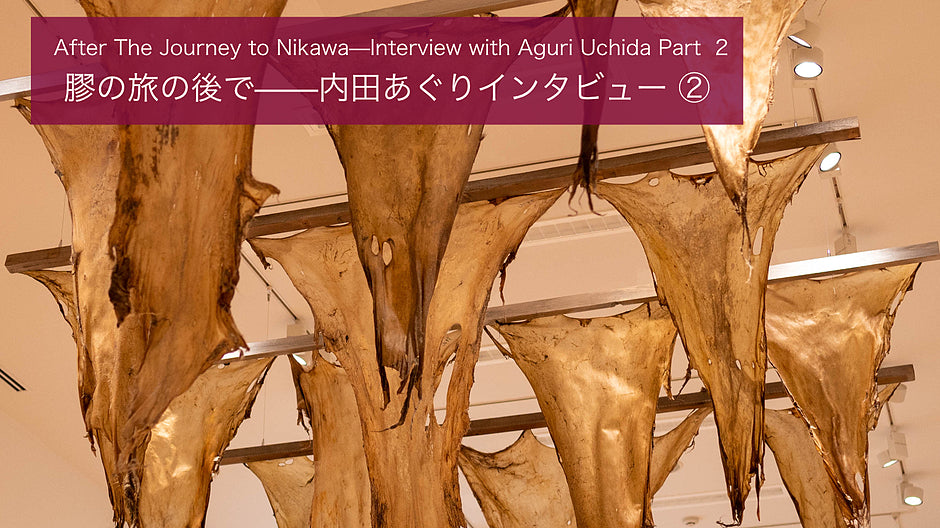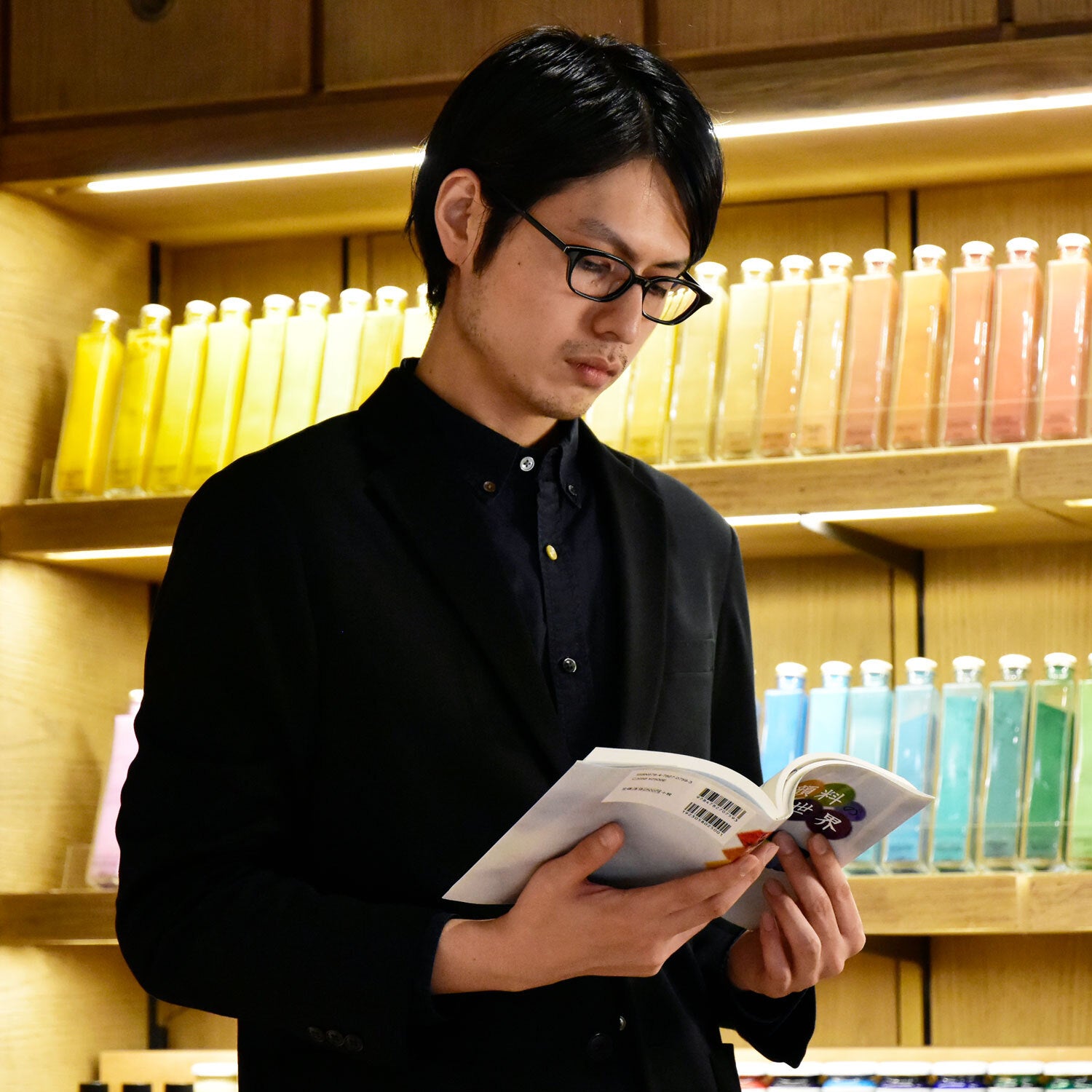「The Journey to Nikawa: Tracing the Cultural Origins」is an exhibition being held at the Musashino Art University Museum & Library from May 12th to June 20th, 2021.
This exhibition was not only about the documentation and value of Nikawa (animal glue) in the art world but also about tracing its "forgotten" roots in the East.
I think it’s fair to say that this is also a project that shone with the aesthetic sense of Aguri Uchida.
In the first part of " After The Journey to Nikawa—Interview with Aguri Uchida," we talked about the background of the exhibition and the overall concept. In the second part, we will explore the “roots” of Prof.Uchida's passion for Nikawa and her insights behind this joint research project.
- Why did you decide to pursue learning Nihonga (Japanese painting)?
A.Uchida: When I was a teenager, I used to study oil painting and design. Back in high school, we had textbooks for art class.
At the time, those textbooks didn't mention Nihonga(Japanese painting) at all, and the only ones that did were "Wind God and Thunder God Screens" by Tawaraya Sōtatsu and Sesshū Tōyō's ink wash paintings on the last few pages printed in black and white.
Of course, no one taught us anything about them at school, so I always wondered, "What are these paintings?”.
So I decided that if I was going to study in this field, I should do something that no one else knows, so I applied to the Department of Japanese Painting at Musashino Art University.
- I heard that it was only after you entered the school that you finally got to practice in Nihonga and Nikawa.
A.Uchida: During my time, the entrance examination for university required pencil sketches and coloring, which needed to be done with Gansai(Japanese pan watercolors) and watercolors on a drawing paper which is coated with Kakishibu (persimmon tannin dye). By the way, I was given a pot of pansies as the setting of the exam.
After I got into the MAU, I was only allowed to use Suihi (tinted pigments) during my freshman year. It was pretty tough and stoical because all we could draw were plant sketches.
- And Musashino Art University is where you met Takashi Asada?
A.Uchida: Yes, Prof. Asada taught me many things that became the source of my ideas and influenced me a lot.

A series of works by Takashi Asada is known for painting surfaces that are made by scraping off the metal leaf.
- There are a few of painting brushes used by Takashi Asada that you usually won't find in a typical Nihonga painting studio.
A.Uchida: Perhaps you mean those strangely cut pig-hair brushes?
They were not used for applying pigments or paint, but to apply the metal leaf and then use those hard bristles to scrape and sharpen the details of the metal leaf before the Nikawa dries.
Prof. Asada had been researching and making full use of unique methods and techniques back then.

Brushes used by Takashi Asada for oil painting. They were used for rubbing off the half-dried metal leaf.
- There are some of your experimental works at the exhibition, such as putting multiple layers of mineral pigments on top of each other.
A.Uchida: To be honest, I didn’t realize there’s anything special by painting that way.
Those experimental works exhibited there are actually from a drawing that I was going to tear up and throw away, but for some reason, I thought that part was pretty, so I decided to cut it out.
I showed them to Tomoyo Ono, the curator of MAU Museum & Library and this exhibition, and she said it would be interesting to exhibit these pieces.
I used several art materials to create the texture of the human body, and then scraped it off with a painting knife or washed the paints and pigments off with a scrubbing brush, then for the rest of the work, I applied a thin layer of paint.
Of course, depending on the method and style I paint, I use different concentrations and amounts of Nikawa.
- This is exactly the kind of expression that only Nikawa can create.
A.Uchida: The greatest ability of Nikawa is that you can technically "wash" the pigments or paints off that are dissolved in Nikawa even after being painted on paper.
And if you pour a little lukewarm water on the painting when you wash it, the layer of paint that contains the Nikawa will “soften” a little and return to its pre-drying state. That allows you to wash and re-scrape the paint. Isn’t it fascinating how flexible the Nikawa and the pigments are?
Since Nikawa has such natural characteristics, I decided to use it in my drawing style.

Experimental works by Auguri Uchida using mineral pigments and Nikawa.
- I can feel the natural characteristics you mentioned from your early works that are exhibited this time.
A.Uchida: Instead of pure or sterilized materials, impurities have always been an affirmation of authenticity to me, such as organic mediums and decaying elements. They give me a strong sense of life.
This might be the reason why I always find animal body fluids like Nikawa beautiful and irresistible. I feel that I can fully “trust” them, or even that I am "drawn" into their vitality.

1976’s paintings by Aguri Uchida, stored in rolls. Nikawa’s high flexibility allows the painting to be peeled off and rolled up without creating any major cracks.
When storing the work after removing it from the drawing board, roll it up with the painting facing outward and lightly spray the painting surface with water to moisten it.
The water softens the Nikawa so it’s able to stretch, making it possible to roll the painting.
- There is a saying that good works often fade away.
A.Uchida: Yes, they do. Living things decay.
It is a natural phenomenon, and I think that the nature of Nihonga and Nikawa are parts of it.
Even though I won’t say it's absolute, it’s just an enigmatic sense.
- What kinds of Nikawa have you tried so far, other than the Sanzenbon?
A.Uchida: I use Nikawa like Nanjin Sika Nikawa (a gelatinous cube-form deer glue) from Tsumaya Nikawa Laboratory and Sanzenbon Nikawa. I usually blend both of them because I find it’s a lot easier to use in this way.
I also use Nikawa from Osaki Shoten, which you can find in this exhibition and they have been a great help in this research too, for the past few years for the base coating.

Nikawa made by Osaki Shoten.
- After this exhibition, is there anything you would like to try or research in the future?
A.Uchida: I just want to create a good painting for now I guess. That is all I really want to do.
- I'm sure you will discover some new ways to blend the Nikawa in the future.
A.Uchida: The Nikawa I use from Osaki Shoten are actually made by traditional manufacturing methods and I’d like to keep using it for a while to see how it goes.
Otherwise, I won’t be able to find the answer to “The Journey to Nikawa.”
To be honest, there are still many places I want to visit in the future and for sure there will be tons of unknowns waiting for me to discover. All I need to do is follow the path and let the ride guide me. I mean the “journey” must go on, right?

Various forms of Nikawa are installed on the walls of the exhibition.
- If you were to go on a new journey, where would you like to go?
A.Uchida: Well, since I didn't get to do my research at a musical instrument factory this time, I would like to visit places where I heard that Nikawa is used in the production and restoration of violins and other instruments. I also want to take a look at how they fix the used wooden furniture by using Nikawa.
In Taiwan, some universities teach Kousaiga (膠彩画 animal glue painting, a type of painting style that is quite similar to Nihonga), and there are Kousaiga artists. In fact, I wanted to do research about Nikawa in Taiwan and Korea too.
Nowadays, we have fewer and fewer opportunities to come across Nikawa, but from a historical perspective, it has an inseparable relationship with the East and the West.
Outside of Japan, Nikawa is being used not only for painting but also as a material for restoring musical instruments and artworks, and sometimes as a way to effectively utilize animals obtained from hunting.
The journey of Aguri Uchida and Nikawa will keep on going in the future. I look forward to what kind of scenery they will show us next.
Perhaps the cultural ruts she has made may nurture the seeds of rediscovering the forgotten East.
Artist Biography

Aguri Uchida
1949 Born in Tokyo
[Recent Major Exhibitions and Art Projects].
2021 The Journey to Nikawa ー Tracing the Cultural Origins, MAU Museum & Library
2020-2021 Aguri Uchida: VOICES, Maruki Gallery For The Hiroshima Panels
2020 Realism of Life: Masterpieces of Nihonga, The Museum of Modern Art, Kamakura & Hayama
2019 AGURI UCHIDA - Incarnated Painting as Inselberg, MAU Museum & Library
2015 私の素描のすべて, Gallery & Books Variété Honroku
2018 1st Opening Anniversary, Saku City Museum of Modern Art Collection & “Introduction to Contemporary Japanese-Style Painting” Event,
Art Museum & Library, Ota
- Numerous other solo, group exhibitions and workshops
[Honors and Awards]
1993 Studied in France as an overseas researcher of the Agency for Cultural Affairs
“Contemporary Nihonga: 12th Yamatane Museum of Art Prize Exhibition” Grand Prize
1999 “Survey of Contemporary Painting in Japan Exhibition” Tokyo Station Gallery Prize
2002 “The 1st Higashiyama Kaii Memorial Nikkei Nihonga Award” Grand Prize
2003-2004 Studied in New York as an overseas researcher of Musashino Art University
2019 Received the “68th Kanagawa Cultural Award”
2021 “The 2nd JAPA TENSHIN Prize” Grand Prize
Exhibition Info
“The Journey to Nikawa ー Tracing the Cultural Origins”
Advisor: Aguri Uchida (Emeritus professor of Musashino Art University)
Place: Musashino Art University Museum & Library
Venue: Gallery 4・5
Date: May 12 (Wed) - June 20 (Sun) 2021
Time: 12:00 - 18:00 (Closes at 17:00 on Saturdays, National Holidays, and Special Opening Days)
Closed: Sundays ※June 13 and 20 will be Special Opening Days
URL:https://mauml.musabi.ac.jp/museum/en/events/17300/
※The exhibition schedule may be shortened or changed based on the further circumstances of COVID-19.
※Starting June 5, MAU M&L will reopen to the public on Saturdays and Sundays only, reservation is required. Check the official website for more information.
*This exhibition has ended.

Reference
“The Journey to Nikawa”by Aguri Uchida (Kokushokankokai Inc., 2021)
Format: B5 size
ISBN:978-4-336-07184-2
Number of pages: 240
Transcription by Natsuko Shiraishi
Written and photographed by Akira Oya
Translated by Atsumi Okano, Nelson Hor Ee Herng
PIGMENT TOKYO Art Materials Expert



